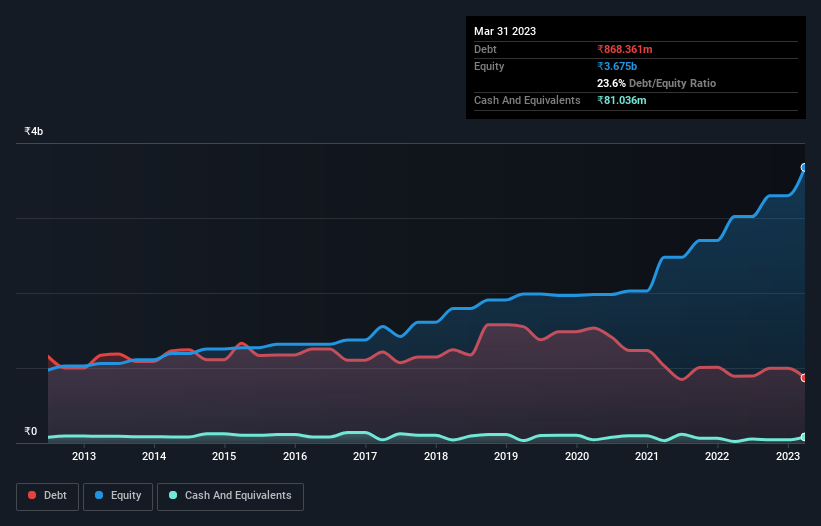- India
- /
- Auto Components
- /
- NSEI:TALBROAUTO
Talbros Automotive Components (NSE:TALBROAUTO) Has A Pretty Healthy Balance Sheet
Howard Marks put it nicely when he said that, rather than worrying about share price volatility, 'The possibility of permanent loss is the risk I worry about... and every practical investor I know worries about.' So it seems the smart money knows that debt - which is usually involved in bankruptcies - is a very important factor, when you assess how risky a company is. We note that Talbros Automotive Components Limited (NSE:TALBROAUTO) does have debt on its balance sheet. But the more important question is: how much risk is that debt creating?
When Is Debt Dangerous?
Generally speaking, debt only becomes a real problem when a company can't easily pay it off, either by raising capital or with its own cash flow. Ultimately, if the company can't fulfill its legal obligations to repay debt, shareholders could walk away with nothing. However, a more common (but still painful) scenario is that it has to raise new equity capital at a low price, thus permanently diluting shareholders. Having said that, the most common situation is where a company manages its debt reasonably well - and to its own advantage. When we examine debt levels, we first consider both cash and debt levels, together.
See our latest analysis for Talbros Automotive Components
How Much Debt Does Talbros Automotive Components Carry?
As you can see below, Talbros Automotive Components had ₹868.4m of debt, at March 2023, which is about the same as the year before. You can click the chart for greater detail. However, it does have ₹81.0m in cash offsetting this, leading to net debt of about ₹787.3m.

How Healthy Is Talbros Automotive Components' Balance Sheet?
According to the last reported balance sheet, Talbros Automotive Components had liabilities of ₹2.65b due within 12 months, and liabilities of ₹236.2m due beyond 12 months. Offsetting this, it had ₹81.0m in cash and ₹1.72b in receivables that were due within 12 months. So its liabilities total ₹1.08b more than the combination of its cash and short-term receivables.
Of course, Talbros Automotive Components has a market capitalization of ₹7.99b, so these liabilities are probably manageable. Having said that, it's clear that we should continue to monitor its balance sheet, lest it change for the worse.
In order to size up a company's debt relative to its earnings, we calculate its net debt divided by its earnings before interest, tax, depreciation, and amortization (EBITDA) and its earnings before interest and tax (EBIT) divided by its interest expense (its interest cover). Thus we consider debt relative to earnings both with and without depreciation and amortization expenses.
Looking at its net debt to EBITDA of 0.90 and interest cover of 5.6 times, it seems to us that Talbros Automotive Components is probably using debt in a pretty reasonable way. But the interest payments are certainly sufficient to have us thinking about how affordable its debt is. One way Talbros Automotive Components could vanquish its debt would be if it stops borrowing more but continues to grow EBIT at around 14%, as it did over the last year. When analysing debt levels, the balance sheet is the obvious place to start. But you can't view debt in total isolation; since Talbros Automotive Components will need earnings to service that debt. So if you're keen to discover more about its earnings, it might be worth checking out this graph of its long term earnings trend.
Finally, a company can only pay off debt with cold hard cash, not accounting profits. So it's worth checking how much of that EBIT is backed by free cash flow. Looking at the most recent three years, Talbros Automotive Components recorded free cash flow of 48% of its EBIT, which is weaker than we'd expect. That's not great, when it comes to paying down debt.
Our View
The good news is that Talbros Automotive Components's demonstrated ability handle its debt, based on its EBITDA, delights us like a fluffy puppy does a toddler. And we also thought its EBIT growth rate was a positive. All these things considered, it appears that Talbros Automotive Components can comfortably handle its current debt levels. Of course, while this leverage can enhance returns on equity, it does bring more risk, so it's worth keeping an eye on this one. When analysing debt levels, the balance sheet is the obvious place to start. But ultimately, every company can contain risks that exist outside of the balance sheet. These risks can be hard to spot. Every company has them, and we've spotted 2 warning signs for Talbros Automotive Components you should know about.
If you're interested in investing in businesses that can grow profits without the burden of debt, then check out this free list of growing businesses that have net cash on the balance sheet.
Valuation is complex, but we're here to simplify it.
Discover if Talbros Automotive Components might be undervalued or overvalued with our detailed analysis, featuring fair value estimates, potential risks, dividends, insider trades, and its financial condition.
Access Free AnalysisHave feedback on this article? Concerned about the content? Get in touch with us directly. Alternatively, email editorial-team (at) simplywallst.com.
This article by Simply Wall St is general in nature. We provide commentary based on historical data and analyst forecasts only using an unbiased methodology and our articles are not intended to be financial advice. It does not constitute a recommendation to buy or sell any stock, and does not take account of your objectives, or your financial situation. We aim to bring you long-term focused analysis driven by fundamental data. Note that our analysis may not factor in the latest price-sensitive company announcements or qualitative material. Simply Wall St has no position in any stocks mentioned.
About NSEI:TALBROAUTO
Talbros Automotive Components
Engages in the manufacture and sale of auto components in India.
Flawless balance sheet second-rate dividend payer.
Similar Companies
Market Insights
Community Narratives




